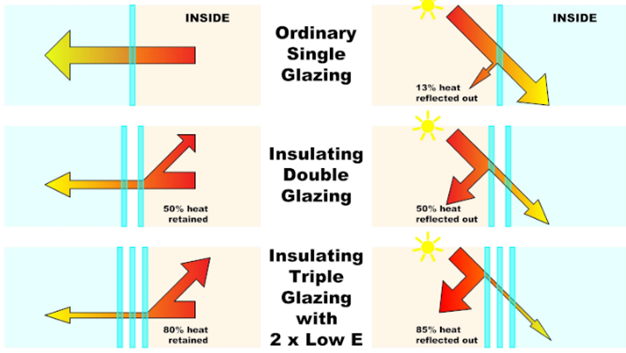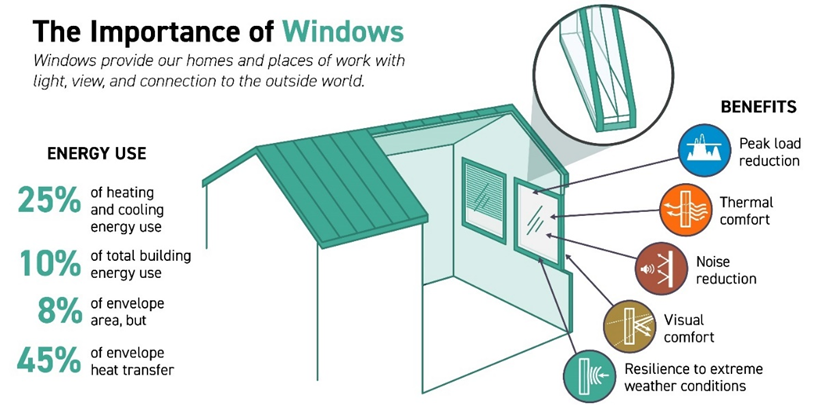

By Deepti Dutt | Mon, December 19, 22
Did you know that windows play an important role in our homes and offices? In general, they’re important in our day-to day lives. They brighten our days as they let the sunlight flow in. But why do windows really matter? They are a critical element in creating indoor spaces that we enjoy. As part of the building envelope, windows offer daylighting and shading systems to help reduce undesirable heat loss and air leakage. In simple terms, they keep the cool and conditioned air indoors in summers and the warm air in during winters.
The picture below shows a rough estimate of the performance of three different types of windows in summer and winter based on glazing and emissivity (E). Low E glass is comprised of extremely thin layers of silver or other low emissivity materials. This layer allows natural light in while deflecting UV rays and Infrared light out into the environment. While windows comprise about eight percent of the total envelope area, typically about 45 percent of heat transfer happens through them. Hence the need for better windows to achieve energy efficient buildings.
Windows have non-energy benefits too, including noise reduction and a visual connection to the surrounding environment. There are studies linking various health aspects to daylight, and growing scientific evidence of the importance of light on human health and wellbeing. I bet you never thought about all the ways windows can directly improve our lives on a daily basis.
The History of Windows
Window technology has come a long way. The Romans were the first to use glass for windows around 100 AD and we can see the evolution of windows throughout our history in the form of forts, churches, palaces and homes. For hundreds of years, we relied on single pane windows for light and ventilation without much concern for their potential role in creating a tighter envelope and more healthy buildings. Before double-pane windows were invented, often a set of separate window sashes were inserted into the frames (storm windows) in winter to increase energy efficiency. These sashes we removed in summer for better ventilation. The oil crisis in the 1970’s led to changes in building regulations. As part of a focus on building regulations, the federal government offered many grants and loans to improve building efficiency, which included double glazed windows. And now with further efforts towards energy efficiency and decarbonization, we see windows that are high-performance, thin, triple paned, vacuum-insulated, and glazed with a layer of Krypton gas.
Windows and Buildings (New and Existing)
As a regional organization focused on driving energy efficiency in homes and buildings, NEEP is keenly aware of the critical role that the “shell” of homes and buildings play in their overall energy use and associated carbon emissions. In fact, the energy use associated with heating and cooling homes and buildings ranks #1 over all other energy usages. If you are looking to buy new windows, either for a new building or to replace old leaky ones in an existing building, here are few things to keep in mind. Windows generally come with a NFRC (National Fenestration Rating Council) label which shows energy performance ratings like U-factor (a measure of how the window conducts energy - the lower the better), Solar Heat Gain Coefficient (the percentage of heat from the sun that gets through the glass), and a brief description of the window. NFRC is an independent organization that rates the energy performance of windows but does not rank them for energy efficiency.
The U.S. Environmental Protection Agency’s ENERGY STAR program, the same program that certifies the energy performance of our appliances, also certifies windows’ energy performance. ENERGY STAR’s new specifications raise the bar. The program requirements and eligibility criteria in version 7.0 make windows more energy efficient. The ENERGY STAR Version 7.0 Residential Windows, Doors, and Skylights specifications take effect on October 23, 2023.
One of these windows is the thin triple pane window. Pacific Northwest National Lab (PNNL) conducted a recent study on Thin Triple Pane Windows, which was presented at ACEEE’s 2022 Summer Study on Energy Efficiency in Buildings. These windows use an ultra-thin center pane of glass with Krypton gas filled to produce an insulated glass unit with similar thickness and weight as a double pane, but with performance that can match heavier, thicker triple pane windows. These windows are easy to install, without any additional retrofit work to the frame. We can realize the energy savings potential of novel technologies developed for windows when these technologies are made mainstream by companies that can market, sell, distribute and support them, and are adopted by building owners, architects and builders.
In existing homes, replacing old, single-glazed windows with new ENERGY STAR® compliant products will provide energy efficiency. A wide range of window attachments (including storm windows, secondary glazing and shades) will also provide improved comfort, energy savings, and lower peak loads.
The U.S. Department of Energy (U.S. DOE), along with regional energy efficiency organizations (like NEEP) and national labs, launched the Partnership for Advanced Window Solutions (PAWS). PAWS partners with vendors of high-performance windows, utilities, trade allies, window manufacturers, glass makers, and home builders to create demand for advanced window solutions. PAWS will support utility programs and assist in developing consumer incentive programs for advanced window solutions.
Conclusion
Adopting high-performance window solutions will help prepare customers for further home electrification in order to meet emissions goals; reduce HVAC/load management; create comfortable, healthy, and resilient homes; and so on. To that end, we must expand consumer awareness of window options, benefits, and cost-, energy-, and emissions savings. When window measures are combined with HVAC and other building envelope upgrades, customers are able to reduce the size and cost of their replacement HVAC equipment because of their improved envelope performance. As per a study on Pathways to Zero Energy Windows: Advancing Technologies and Market Adoption by National Renewable Energy Lab (NREL), design modifications to the frames, advanced glazing packages (like thin triple, or vacuum insulated glazing), higher performing inert gas fills (like Krypton), or replacing the fills with a transparent low conductivity solid material and developing highly insulated window spacers and subcomponents are essential to achieving better window performance. NEEP is excited to be working with stakeholders in the region, and beyond, to support the market growth of high-performance window solutions.


